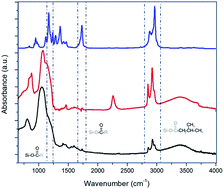The shell matters: one step synthesis of core–shell silicon nanoparticles with room temperature ultranarrow emission linewidth†
Abstract
Here we present a one-step synthesis that provides silicon nanocrystals with a thin shell composed of a ceramic-like carbonyl based compound, embedded in a porous organosilicon film. The silicon nanocrystals were synthesised from hydrogen silsesquioxane molecules, modified with organic molecules containing carbonyl groups, which were annealed at 1000 °C in a slightly reducing 5% H2 : 95% Ar atmosphere. The organic character of the shell was preserved after annealing due to trapping of organic molecules inside the HSQ-derived oxide matrix that forms during the annealing. The individual silicon nanocrystals, studied by single dot spectroscopy, exhibited a significantly narrower emission peak at room temperature (lowest linewidth ∼ 17 meV) compared to silicon nanocrystals embedded in a silicon oxide shell (150 meV). Their emission linewidths are even significantly narrower than those of single CdSe quantum dots (>50 meV). It is hypothesized that the Si-core–thin shell structure of the nanoparticle is responsible for the unique optical properties. Its formation within one synthesis step opens new opportunities for silicon-based quantum dots. The luminescence from the produced nanocrystals covers a broad spectral range from 530–720 nm (1.7–2.3 eV) suggesting strong application potential for solar cells and LEDs, following the development of a suitable mass-fabrication protocol.

- This article is part of the themed collection: Luminescent silicon nanostructures


 Please wait while we load your content...
Please wait while we load your content...